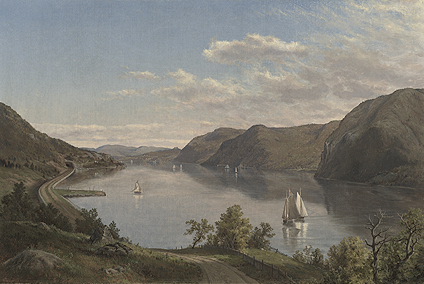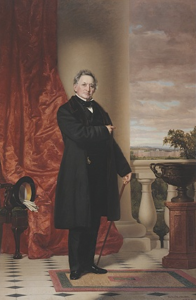Along with Vassar College, the Art Center is celebrating the sesquicentennial anniversary of our founding. In this weekly feature, we will look back on the rich 150-year history of the collection. Today’s post comes from Lauren Goldberg, Vassar College class of 2011 and Art Center student docent.

With the Sesquicentennial celebrations in full swing, students and faculty have been delving into Vassar’s vibrant history more than ever. This milestone of 150 years has inspired us to dig up old photos from the college’s earlier years, to reflect upon the transformation of long-standing traditions, and to illuminate rich stories of Vassar’s founding and growth.

Elias L. Magoon, one of the founding trustees of Vassar and chairman of Vassar’s Art Gallery Committee, was known for his extensive art collection, which he sold to Vassar. As someone who took initiative in assembling a collection of American art, Magoon was in direct correspondence with many artists associated with the Hudson River School. One such artist, Charles Herbert Moore, is closely tied to Vassar as he was almost Vassar’ first and only Art Department faculty member. Magoon purchased four landscape oil paintings from Moore and had received sparkling recommendations on his behalf from established artists Frederick Church and Asher B. Durand. But Matthew Vassar decided to hire Henry Van Ingen instead. Van Ingen was formerly a professor at the University of Rochester where Matthew Vassar was a trustee. In charge of Vassar’s School of Art (a separate branch of the college at the time), Van Ingen was dedicated to providing the female students with a hands-on art education and easy access to original paintings by artists like Moore.
If you have had the chance to visit the new Hudson River School Galleries, housing Vassar’s beautiful collection of landscape paintings, you may already be familiar with works by Charles Herbert Moore. I have had the opportunity to spend time studying Moore’s Down The Hudson to West Point and now consider it my favorite of his pieces in the collection. This painting is a wonderful example of Moore’s meticulous attention to detail and composition, as well as his commitment to capturing the majesty of nature. This painting is even more fascinating to me because it embodies a panorama of the Hudson Valley from 1861—when New York was on the cusp of industrial development and Vassar College was in its infancy. Taking a close look at the left side of the canvas, the viewer can see a hint of cart path where, in reality, a railroad had been recently constructed. Researchers of this painting have questioned whether Moore deliberately excluded the newly-introduced commercial transportation to comment upon the destruction of nature by industrialism, or if he merely wanted to provide his patron with a more favorable natural landscape. I encourage you all to take a close look at this painting and think about how Moore was responding to this familiar landscape and to the artistic and intellectual environment of the time. How would you portray the Hudson Valley now—150 years later?




